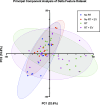Radiomics approach for identifying radiation-induced normal tissue toxicity in the lung
- PMID: 39415029
- PMCID: PMC11484882
- DOI: 10.1038/s41598-024-75993-y
Radiomics approach for identifying radiation-induced normal tissue toxicity in the lung
Abstract
The rapidly evolving field of radiomics has shown that radiomic features are able to capture characteristics of both tumor and normal tissue that can be used to make accurate and clinically relevant predictions. In the present study we sought to determine if radiomic features can characterize the adverse effects caused by normal tissue injury as well as identify if human embryonic stem cell (hESC) derived extracellular vesicle (EV) treatment can resolve certain adverse complications. A cohort of 72 mice (n = 12 per treatment group) were exposed to X-ray radiation to the whole lung (3 × 8 Gy) or to the apex of the right lung (3 × 12 Gy), immediately followed by retro-orbital injection of EVs. Cone-Beam Computed Tomography images were acquired before and 2 weeks after treatment. In total, 851 radiomic features were extracted from the whole lungs and < 20 features were selected to train and validate a series of random forest classification models trained to predict radiation status, EV status and treatment group. It was found that all three classification models achieved significantly high prediction accuracies on a validation subset of the dataset (AUCs of 0.91, 0.86 and 0.80 respectively). In the locally irradiated lung, a significant difference between irradiated and unirradiated groups as well as an EV sparing effect were observed in several radiomic features that were not seen in the unirradiated lung (including wavelet-LLH Kurtosis, wavelet HLL Large Area High Gray Level Emphasis, and Gray Level Non-Uniformity). Additionally, a radiation difference was not observed in a secondary comparison cohort, but there was no impact of imaging machine parameters on the radiomic signature of unirradiated mice. Our data demonstrate that radiomics has the potential to identify radiation-induced lung injury and could be applied to predict therapeutic efficacy at early timepoints.
Keywords: Extracellular vesicles; Machine learning; Radiomics; Radiotherapy.
© 2024. The Author(s).
Conflict of interest statement
The authors declare no competing interests.
Figures








Update of
-
Radiomics approach for identifying radiation-induced normal tissue toxicity in the lung.Res Sq [Preprint]. 2024 Feb 23:rs.3.rs-3951996. doi: 10.21203/rs.3.rs-3951996/v1. Res Sq. 2024. Update in: Sci Rep. 2024 Oct 16;14(1):24256. doi: 10.1038/s41598-024-75993-y. PMID: 38464210 Free PMC article. Updated. Preprint.
Similar articles
-
Radiomics approach for identifying radiation-induced normal tissue toxicity in the lung.Res Sq [Preprint]. 2024 Feb 23:rs.3.rs-3951996. doi: 10.21203/rs.3.rs-3951996/v1. Res Sq. 2024. Update in: Sci Rep. 2024 Oct 16;14(1):24256. doi: 10.1038/s41598-024-75993-y. PMID: 38464210 Free PMC article. Updated. Preprint.
-
Characterisation of quantitative imaging biomarkers for inflammatory and fibrotic radiation-induced lung injuries using preclinical radiomics.Radiother Oncol. 2024 Mar;192:110106. doi: 10.1016/j.radonc.2024.110106. Epub 2024 Jan 20. Radiother Oncol. 2024. PMID: 38253201
-
Magnetic resonance imaging radiomics predicts preoperative axillary lymph node metastasis to support surgical decisions and is associated with tumor microenvironment in invasive breast cancer: A machine learning, multicenter study.EBioMedicine. 2021 Jul;69:103460. doi: 10.1016/j.ebiom.2021.103460. Epub 2021 Jul 4. EBioMedicine. 2021. PMID: 34233259 Free PMC article. Clinical Trial.
-
Radiomics and deep learning in lung cancer.Strahlenther Onkol. 2020 Oct;196(10):879-887. doi: 10.1007/s00066-020-01625-9. Epub 2020 May 4. Strahlenther Onkol. 2020. PMID: 32367456 Review.
-
Radiomics in predicting treatment response in non-small-cell lung cancer: current status, challenges and future perspectives.Eur Radiol. 2021 Feb;31(2):1049-1058. doi: 10.1007/s00330-020-07141-9. Epub 2020 Aug 18. Eur Radiol. 2021. PMID: 32809167 Free PMC article. Review.
Cited by
-
Machine learning-driven imaging data for early prediction of lung toxicity in breast cancer radiotherapy.Sci Rep. 2025 May 27;15(1):18473. doi: 10.1038/s41598-025-02617-4. Sci Rep. 2025. PMID: 40425645 Free PMC article.
References
-
- Gardin, I. et al. Radiomics: principles and radiotherapy applications. Crit. Rev. Oncol. Hematol. 138, 44–50 (2019). - PubMed
MeSH terms
Grants and funding
LinkOut - more resources
Full Text Sources
Miscellaneous

